2023 年 64 巻 4 号 p. 813-816
2023 年 64 巻 4 号 p. 813-816
Kink boundaries formed in Mg-based long period stacking order (LPSO) alloys play a key role in strengthening of these materials. As the kink structure grows, many high-angle kink boundaries are eventually formed which has inclination angle close to 34 degrees. We show that this peculiar structure is a result of irreversible structural transformation and is energetically stable. We also calculate segregation energies of alloying elements Y and Zn to this boundary. Finally, the critical resolved shear stress for the migration of kink boundary is estimated for a pure-Mg kink and that with saturated with segregation. We show that segregated kink boundary requires very high shear stress about 700 MPa for migration.

It has been shown that Mg-based long period stacking order (LPSO) alloys show remarkable strength after treatment at high temperature.1–12) A unique microstructure referred to as “kink boundary” are introduced in the treatment process13) and it has been speculated that these kink boundaries play key role in strengthening, although the precise strengthening mechanism remains unclear. It is noteworthy that kink boundaries are strong obstacle for motion of basal dislocations which are the source of plastic deformation.14) Figure 1 shows a schematic structure after a basal dislocation passed through a kink boundary. Since the passage of a dislocation inevitably introduces mismatch in basal layers and costs high energy, this kind of process is strongly suppressed, unless some ⟨c⟩-component dislocation is introduced to heal the mismatch in basal planes, or kink boundary migrates to accommodate the displacement. Note that kink boundary migration itself induces plastic deformation without any other motion of dislocation, because the boundary can be regarded as a vertical allay of edge dislocations.
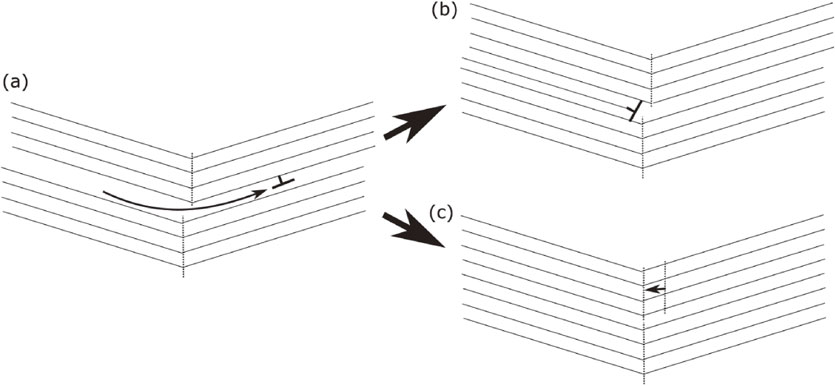
Schematic of edge dislocation passage through kink boundary. (a) Glide of edge dislocation induces mismatch of basal layers. (b) Induced mismatch can be healed by introduction of ⟨c⟩ component dislocation. (c) Mismatch can also be healed by migration of kink boundary.
The obstacle effect is stronger for boundaries with higher angles. As the kink structure is developed, the angles of kink boundaries become larger. After sufficient growth, a typical angle of about 34 degrees is frequently observed. This structure corresponds to a twin-like boundary with Miller index (2-1-16)/6 in the simple hexagonal close-packed (HCP) lattice, as shown in Fig. 2. It should be noted that this plane is compatible with any kind of stacking order, such as 18R, 10H and 2H. Even after this kind of high-angle boundaries are densely introduced to the material, plastic deformation is still possible. Thus there should be some mechanism for deformation, either by dislocation migration accompanied by generation of c-type dislocations, or migration of kink boundaries. Very dense segregation of solute atoms on the kink boundaries are observed, and it is expected that this kind of boundary requires very strong stress for migration.
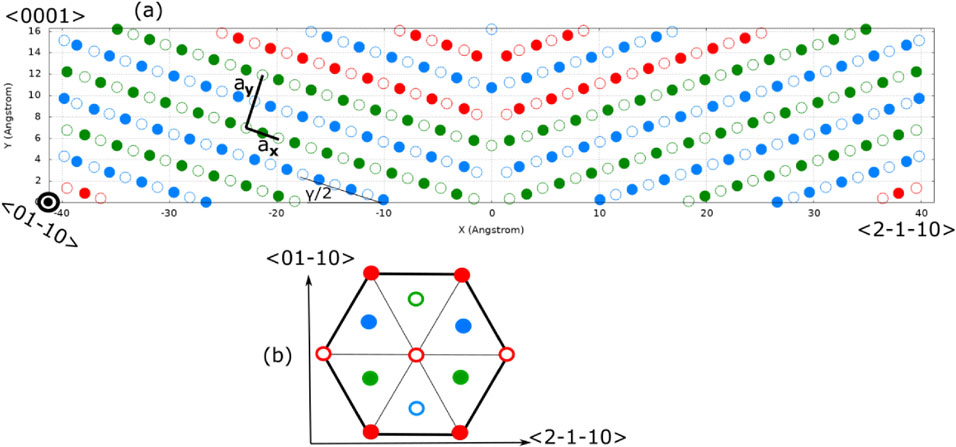
Atomistic configuration of 34-degree, (2-1-16)/6 kink boundary introduced to 18-R structure of Mg. (b) Colors of atoms correspond to their coordinate along ⟨01-10⟩ direction.
In the present work, we investigate the atomistic structure of the twin-like (2-1-16)/6 boundary using DFT calculations. For simplicity, we do not include solute clusters formed in the LPSO phase and use the 18R stacking structure consisted of only Mg atoms as a base structure. Because addition of solute clusters increases energy barrier for basal slip, critical resolved shear stress (CRSS) for boundary migration is expected to be larger for the actual LPSO structure and CRSS estimated without solute cluster gives lower bound for the LPSO case. Solute segregation energies at the boundary are also calculated and the atomistic structure of boundary saturated with solute atoms are also calculated. Finally, shear stress required for the boundary migration is estimated for pure-Mg boundary and solute-saturated boundary. We have found that solute atoms densely segregate at kink boundary and increase CRSS from 400 MPa to 700 MPa.
Electronic structure calculations and structural relaxation by force minimization in DFT calculations were performed using the Vienna Ab-initio Simulation Package (VASP)15,16) with the projector augmented wave method and ultrasoft pseudopotentials. The exchange correlation energy was calculated using the generalized gradient approximation (GGA) with the Perdew-Burke-Ernzerhof function.17) The Methfessel-Paxton smearing method with 0.2-eV width was used. The cutoff energy for the plane-wave basis set was 360 eV, and the convergence of cluster binding energy with respect to increasing cutoff was confirmed. Structural relaxation terminated when the maximum force acting on the movable degrees of freedom became less than 10 meV/Angstrom. For the supercell, single, Gamma-centered k-point were used. The calculation cell lengths are $N_{x}a_{x}\cos ( \frac{\gamma }{2} )$, $N_{y}a_{y}/\cos ( \frac{\gamma }{2} )$, and az along X, Y and Z axis, respectively. Nx and Ny denote number of hcp unit cells in X and Y direction, ax, ay and az are unit cell lengths of simple hcp lattice and γ is inclination angle, as shown in Fig. 2. The initial structure consists of six basal layers with 18R-type stacking “ABACBC…”. The cell shape is a rhombohedron with slanted c-axis ⟨1-100⟩/6 +3⟨0001⟩. Periodic boundary conditions are used in all directions. Initial configurations have been relaxed by MEAM potential for Mg developed by Wu et al.18)
Segregation energy of solute elements Y and Zn is estimated by substituting Mg atom near or on the kink boundary by these elements and calculating the total energy. The energy difference between this energy and that of reference state, where an atom far from the boundary is substituted by a solute atom, is regarded as a segregation energy.19) Since the calculation cell is very thin along the Z direction, this segregation energy corresponds to that of saturated state.
Responses of kink boundaries to the shear stress are investigated by applying uniform shear strain in Y-X component and doing relaxation. Shear strain is increased by 1% at each step, followed by structural relaxation.
We have found that the atomistic configuration of kink boundary becomes asymmetric with respect to the boundary surface if small random displacement is added to each atom before relaxation. Figure 3 shows relaxed structure of symmetric and asymmetric kink boundary. The boundary surface energy for the symmetric one is 0.11 J/m2, whereas for asymmetric one it is 0.01 J/m2. It should be noted that this small surface energy does not corresponds to the actual surface energy of kink boundary. The reference state for the calculation of surface energy, namely 18R stacking structure consisting of only Mg atoms, is not a lowest-energy structure and include stacking faults. When a kink boundary is introduced, some part of stacking fault is eliminated, lowering the total energy. In the actual LPSO structure, stacking fault is stabilized by solute atoms and kink boundary should have much higher surface energy.
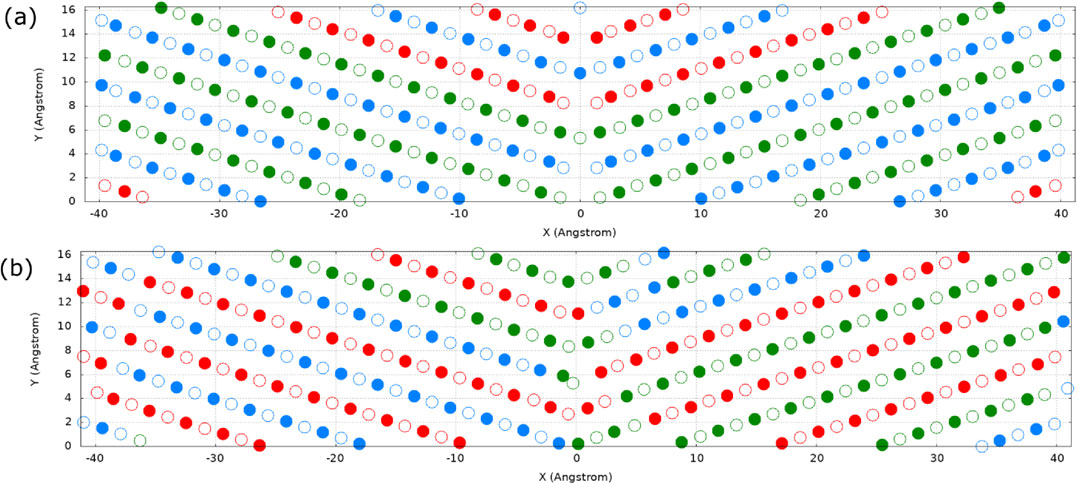
Atomistic configurations of (a) symmetric and (b) asymmetric (2-1-16)/6 kink boundaries obtained by DFT relaxation. Asymmetric boundary has lower surface energy.
Figure 4 and Table 1 shows segregation energy of Y and Zn atoms near the kink boundary. We have found that segregation energy of Zn atoms is larger than that of Y. The largest segregation energy for Zn atoms is about 0.7 eV which corresponds to almost 100% occupation of Zn atoms of these sites at room temperature. The large segregation energy of Zn is a result of significant change of atomistic structure near the boundary. Once this change happens, addition of Zn atom to a nearby site does not induce the same amount of change and corresponding segregation energy becomes modest one. To obtain boundary configuration with saturated segregation, solute atoms are placed at segregation sites one by one, and energy gain by the segregation is evaluated. This process is repeated until the energy gain by new segregation becomes less than 0.15 eV. Figure 5 shows kink boundary configuration with saturated Zn and Y atoms obtained by aforementioned method. Extensive change of atomistic structure is induced by the segregation of Zn and Y atoms.

Positions of segregation sites 1 through 26 near the asymmetric boundary investigated in DFT calculation. Segregation energy for Zn and Y is shown in Table 1.
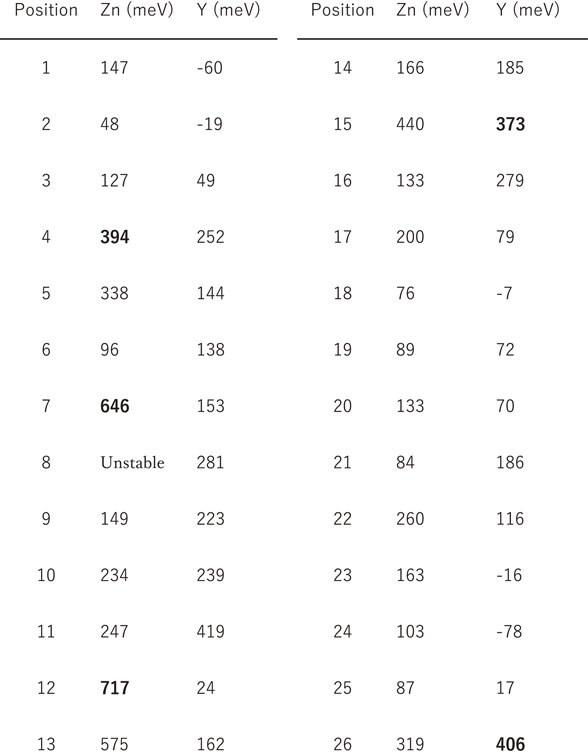
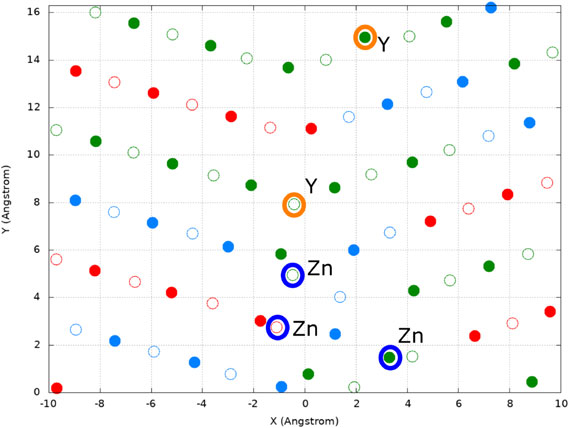
Atomistic configuration of asymmetric kink boundary with saturated segregation, obtained by DFT relaxation.
Figure 6 shows stress-strain relation for the applied shear stress in Y-X component with respect to the Cartesian coordinate axis shown in Fig. 5. The drop in stress corresponds to migration of kink boundary. Without solute atoms, the critical resolved shear stress (CRSS) for boundary migration is about 400 MPa, whereas saturation of solute atoms increases the CRSS to about 700 MPa. In the actual LPSO structure where hard solute clusters prevent local shuffling of atoms, the CRSS for boundary migration should be much higher.
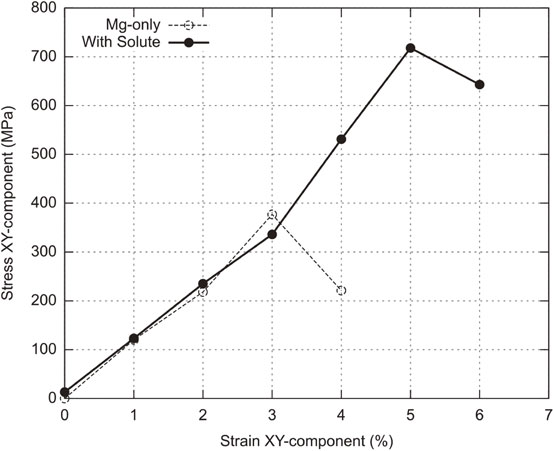
Stress-strain relation for the applied shear stress acting on the kink boundary with and without solute atoms. The drops in stress correspond to migration of kink boundary.
We have investigated atomistic structure of high-angle kink boundary in Mg-based LPSO alloy using DFT calculations. In all calculations, 18R structure without solute cluster is used for simplicity to estimate solute segregation energy to the boundary and CRSS of boundary migration. In the actual LPSO alloy, solute clusters should restrict some of local atomistic shuffling observed in the present work. This results in lower solute segregation energy and higher CRSS. Therefore, the CRSS obtained in the present work is a lower bound for the actual CRSS. The estimated CRSS of 700 MPa for the solute-saturated boundary is already very high, and indicates that migration of kink boundary with solute segregation requires strong stress concentration in LPSO alloys, unless accompanied by cooperative migration of solute atoms on the boundary.
This work was supported by JSPS KAKENHI for Scientific Research on Innovative Areas “Materials Science of a Mille-feuille Structure” (Grant Numbers 18H05480, 18H05479). Computations were performed on the SGI-8600 at the Japan Atomic Energy Agency.